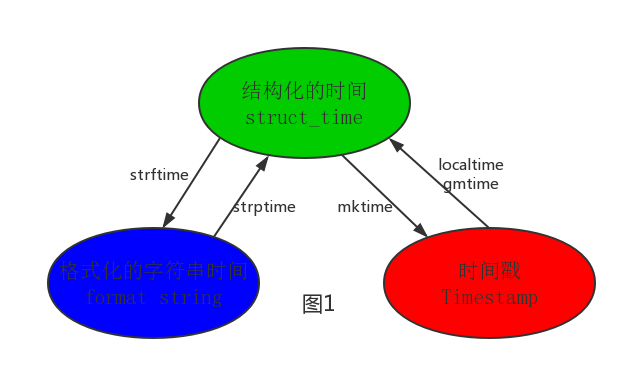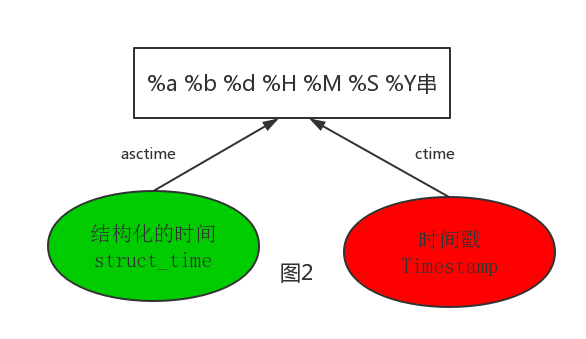一、时间模块
- 时间戳(timestamp):通常来说,时间戳表示的是从1970年1月1日00:00:00开始按秒计算的偏移量。我们运行“type(time.time())”,返回的是float类型。
- 格式化的时间字符串(Format String)
- 结构化的时间(struct_time):struct_time元组共有9个元素共九个元素:(年,月,日,时,分,秒,一年中第几周,一年中第几天,夏令时)
import time
#--------------------------我们先以当前时间为准,让大家快速认识三种形式的时间
print(time.time()) # 时间戳:1487130156.419527
print(time.strftime("%Y-%m-%d %X")) #格式化的时间字符串:'2017-02-15 11:40:53'
print(time.localtime()) #本地时区的struct_time
print(time.gmtime()) #UTC时区的struct_time
%a Locale’s abbreviated weekday name. %A Locale’s full weekday name. %b Locale’s abbreviated month name. %B Locale’s full month name. %c Locale’s appropriate date and time representation. %d Day of the month as a decimal number [01,31]. %H Hour (24-hour clock) as a decimal number [00,23]. %I Hour (12-hour clock) as a decimal number [01,12]. %j Day of the year as a decimal number [001,366]. %m Month as a decimal number [01,12]. %M Minute as a decimal number [00,59]. %p Locale’s equivalent of either AM or PM. (1) %S Second as a decimal number [00,61]. (2) %U Week number of the year (Sunday as the first day of the week) as a decimal number [00,53]. All days in a new year preceding the first Sunday are considered to be in week 0. (3) %w Weekday as a decimal number [0(Sunday),6]. %W Week number of the year (Monday as the first day of the week) as a decimal number [00,53]. All days in a new year preceding the first Monday are considered to be in week 0. (3) %x Locale’s appropriate date representation. %X Locale’s appropriate time representation. %y Year without century as a decimal number [00,99]. %Y Year with century as a decimal number. %z Time zone offset indicating a positive or negative time difference from UTC/GMT of the form +HHMM or -HHMM, where H represents decimal hour digits and M represents decimal minute digits [-23:59, +23:59]. %Z Time zone name (no characters if no time zone exists). %% A literal '%' character. 格式化字符串的时间格式

#--------------------------按图1转换时间 # localtime([secs]) # 将一个时间戳转换为当前时区的struct_time。secs参数未提供,则以当前时间为准。 time.localtime() time.localtime(1473525444.037215) # gmtime([secs]) 和localtime()方法类似,gmtime()方法是将一个时间戳转换为UTC时区(0时区)的struct_time。 # mktime(t) : 将一个struct_time转化为时间戳。 print(time.mktime(time.localtime()))#1473525749.0 # strftime(format[, t]) : 把一个代表时间的元组或者struct_time(如由time.localtime()和 # time.gmtime()返回)转化为格式化的时间字符串。如果t未指定,将传入time.localtime()。如果元组中任何一个 # 元素越界,ValueError的错误将会被抛出。 print(time.strftime("%Y-%m-%d %X", time.localtime()))#2016-09-11 00:49:56 # time.strptime(string[, format]) # 把一个格式化时间字符串转化为struct_time。实际上它和strftime()是逆操作。 print(time.strptime('2011-05-05 16:37:06', '%Y-%m-%d %X')) #time.struct_time(tm_year=2011, tm_mon=5, tm_mday=5, tm_hour=16, tm_min=37, tm_sec=6, # tm_wday=3, tm_yday=125, tm_isdst=-1) #在这个函数中,format默认为:"%a %b %d %H:%M:%S %Y"。

#--------------------------按图2转换时间 # asctime([t]) : 把一个表示时间的元组或者struct_time表示为这种形式:'Sun Jun 20 23:21:05 1993'。 # 如果没有参数,将会将time.localtime()作为参数传入。 print(time.asctime())#Sun Sep 11 00:43:43 2016 # ctime([secs]) : 把一个时间戳(按秒计算的浮点数)转化为time.asctime()的形式。如果参数未给或者为 # None的时候,将会默认time.time()为参数。它的作用相当于time.asctime(time.localtime(secs))。 print(time.ctime()) # Sun Sep 11 00:46:38 2016 print(time.ctime(time.time())) # Sun Sep 11 00:46:38 2016


时间加减:

#时间加减 import datetime # print(datetime.datetime.now()) #返回 2016-08-19 12:47:03.941925 #print(datetime.date.fromtimestamp(time.time()) ) # 时间戳直接转成日期格式 2016-08-19 # print(datetime.datetime.now() ) # print(datetime.datetime.now() + datetime.timedelta(3)) #当前时间+3天 # print(datetime.datetime.now() + datetime.timedelta(-3)) #当前时间-3天 # print(datetime.datetime.now() + datetime.timedelta(hours=3)) #当前时间+3小时 # print(datetime.datetime.now() + datetime.timedelta(minutes=30)) #当前时间+30分 # # c_time = datetime.datetime.now() # print(c_time.replace(minute=3,hour=2)) #时间替换 datetime模块
二、random模块

import random print(random.random())#(0,1)----float 大于0且小于1之间的小数 print(random.randint(1,3)) #[1,3] 大于等于1且小于等于3之间的整数 print(random.randrange(1,3)) #[1,3) 大于等于1且小于3之间的整数 print(random.choice([1,'23',[4,5]]))#1或者23或者[4,5] print(random.sample([1,'23',[4,5]],2))#列表元素任意2个组合 print(random.uniform(1,3))#大于1小于3的小数,如1.927109612082716 item=[1,3,5,7,9] random.shuffle(item) #打乱item的顺序,相当于"洗牌" print(item)

import random def make_code(n): res='' for i in range(n): s1=chr(random.randint(65,90)) s2=str(random.randint(0,9)) res+=random.choice([s1,s2]) return res print(make_code(9)) 生成随机验证码
三、OS模块
1.os模块是与操作系统交互的一个接口

os.getcwd() 获取当前工作目录,即当前python脚本工作的目录路径 os.chdir("dirname") 改变当前脚本工作目录;相当于shell下cd os.curdir 返回当前目录: ('.') os.pardir 获取当前目录的父目录字符串名:('..') os.makedirs('dirname1/dirname2') 可生成多层递归目录 os.removedirs('dirname1') 若目录为空,则删除,并递归到上一级目录,如若也为空,则删除,依此类推 os.mkdir('dirname') 生成单级目录;相当于shell中mkdir dirname os.rmdir('dirname') 删除单级空目录,若目录不为空则无法删除,报错;相当于shell中rmdir dirname os.listdir('dirname') 列出指定目录下的所有文件和子目录,包括隐藏文件,并以列表方式打印 os.remove() 删除一个文件 os.rename("oldname","newname") 重命名文件/目录 os.stat('path/filename') 获取文件/目录信息 os.sep 输出操作系统特定的路径分隔符,win下为"\",Linux下为"/" os.linesep 输出当前平台使用的行终止符,win下为" ",Linux下为" " os.pathsep 输出用于分割文件路径的字符串 win下为;,Linux下为: os.name 输出字符串指示当前使用平台。win->'nt'; Linux->'posix' os.system("bash command") 运行shell命令,直接显示 os.environ 获取系统环境变量 os.path.abspath(path) 返回path规范化的绝对路径 os.path.split(path) 将path分割成目录和文件名二元组返回 os.path.dirname(path) 返回path的目录。其实就是os.path.split(path)的第一个元素 os.path.basename(path) 返回path最后的文件名。如何path以/或结尾,那么就会返回空值。即os.path.split(path)的第二个元素 os.path.exists(path) 如果path存在,返回True;如果path不存在,返回False os.path.isabs(path) 如果path是绝对路径,返回True os.path.isfile(path) 如果path是一个存在的文件,返回True。否则返回False os.path.isdir(path) 如果path是一个存在的目录,则返回True。否则返回False os.path.join(path1[, path2[, ...]]) 将多个路径组合后返回,第一个绝对路径之前的参数将被忽略 os.path.getatime(path) 返回path所指向的文件或者目录的最后存取时间 os.path.getmtime(path) 返回path所指向的文件或者目录的最后修改时间 os.path.getsize(path) 返回path的大小
2.
在Linux和Mac平台上,该函数会原样返回path,在windows平台上会将路径中所有字符转换为小写,并将所有斜杠转换为饭斜杠。
>>> os.path.normcase('c:/windows\system32\')
'c:\windows\system32\'
规范化路径,如..和/
>>> os.path.normpath('c://windows\System32\../Temp/')
'c:\windows\Temp'
>>> a='/Users/jieli/test1/\a1/\\aa.py/../..'
>>> print(os.path.normpath(a))
/Users/jieli/test1
3.OS路径处理

os路径处理 #方式一:推荐使用 import os #具体应用 import os,sys possible_topdir = os.path.normpath(os.path.join( os.path.abspath(__file__), os.pardir, #上一级 os.pardir, os.pardir )) sys.path.insert(0,possible_topdir) #方式二:不推荐使用 os.path.dirname(os.path.dirname(os.path.dirname(os.path.abspath(__file__))))
四、sys模块
1 sys.argv 命令行参数List,第一个元素是程序本身路径
2 sys.exit(n) 退出程序,正常退出时exit(0)
3 sys.version 获取Python解释程序的版本信息
4 sys.maxint 最大的Int值
5 sys.path 返回模块的搜索路径,初始化时使用PYTHONPATH环境变量的值
6 sys.platform 返回操作系统平台名称

#=========知识储备========== #进度条的效果 [# ] [## ] [### ] [#### ] #指定宽度 print('[%-15s]' %'#') print('[%-15s]' %'##') print('[%-15s]' %'###') print('[%-15s]' %'####') #打印% print('%s%%' %(100)) #第二个%号代表取消第一个%的特殊意义 #可传参来控制宽度 print('[%%-%ds]' %50) #[%-50s] print(('[%%-%ds]' %50) %'#') print(('[%%-%ds]' %50) %'##') print(('[%%-%ds]' %50) %'###') #=========实现打印进度条函数========== import sys import time def progress(percent,width=50): if percent >= 1: percent=1 show_str=('[%%-%ds]' %width) %(int(width*percent)*'#') print(' %s %d%%' %(show_str,int(100*percent)),file=sys.stdout,flush=True,end='') #=========应用========== data_size=1025 recv_size=0 while recv_size < data_size: time.sleep(0.1) #模拟数据的传输延迟 recv_size+=1024 #每次收1024 percent=recv_size/data_size #接收的比例 progress(percent,width=70) #进度条的宽度70 打印进度条
五、shutil模块
高级的 文件、文件夹、压缩包 处理模块
shutil.copyfileobj(fsrc, fdst[, length])
将文件内容拷贝到另一个文件中
1 import shutil
2
3 shutil.copyfileobj(open('old.xml','r'), open('new.xml', 'w'))
shutil.copyfile(src, dst)
拷贝文件
1 shutil.copyfile('f1.log', 'f2.log') #目标文件无需存在
shutil.copymode(src, dst)
仅拷贝权限。内容、组、用户均不变
1 shutil.copymode('f1.log', 'f2.log') #目标文件必须存在
shutil.copystat(src, dst)
仅拷贝状态的信息,包括:mode bits, atime, mtime, flags
1 shutil.copystat('f1.log', 'f2.log') #目标文件必须存在
shutil.copy(src, dst)
拷贝文件和权限
1 import shutil
2
3 shutil.copy('f1.log', 'f2.log')
shutil.copy2(src, dst)
拷贝文件和状态信息
1 import shutil
2
3 shutil.copy2('f1.log', 'f2.log')
shutil.ignore_patterns(*patterns)
shutil.copytree(src, dst, symlinks=False, ignore=None)
递归的去拷贝文件夹
1 import shutil
2
3 shutil.copytree('folder1', 'folder2', ignore=shutil.ignore_patterns('*.pyc', 'tmp*')) #目标目录不能存在,注意对folder2目录父级目录要有可写权限,ignore的意思是排除


import shutil
shutil.copytree('f1', 'f2', symlinks=True, ignore=shutil.ignore_patterns('*.pyc', 'tmp*'))
'''
通常的拷贝都把软连接拷贝成硬链接,即对待软连接来说,创建新的文件
'''
shutil.rmtree(path[, ignore_errors[, onerror]])
递归的去删除文件
1 import shutil
2
3 shutil.rmtree('folder1')
shutil.move(src, dst)
递归的去移动文件,它类似mv命令,其实就是重命名。
1 import shutil
2
3 shutil.move('folder1', 'folder3')
shutil.make_archive(base_name, format,...)
创建压缩包并返回文件路径,例如:zip、tar
创建压缩包并返回文件路径,例如:zip、tar
- base_name: 压缩包的文件名,也可以是压缩包的路径。只是文件名时,则保存至当前目录,否则保存至指定路径,
如 data_bak =>保存至当前路径
如:/tmp/data_bak =>保存至/tmp/ - format: 压缩包种类,“zip”, “tar”, “bztar”,“gztar”
- root_dir: 要压缩的文件夹路径(默认当前目录)
- owner: 用户,默认当前用户
- group: 组,默认当前组
- logger: 用于记录日志,通常是logging.Logger对象
1 #将 /data 下的文件打包放置当前程序目录
2 import shutil
3 ret = shutil.make_archive("data_bak", 'gztar', root_dir='/data')
4
5
6 #将 /data下的文件打包放置 /tmp/目录
7 import shutil
8 ret = shutil.make_archive("/tmp/data_bak", 'gztar', root_dir='/data')
shutil 对压缩包的处理是调用 ZipFile 和 TarFile 两个模块来进行的,详细:


import zipfile
# 压缩
z = zipfile.ZipFile('laxi.zip', 'w')
z.write('a.log')
z.write('data.data')
z.close()
# 解压
z = zipfile.ZipFile('laxi.zip', 'r')
z.extractall(path='.')
z.close()


import tarfile
# 压缩
>>> t=tarfile.open('/tmp/egon.tar','w')
>>> t.add('/test1/a.py',arcname='a.bak')
>>> t.add('/test1/b.py',arcname='b.bak')
>>> t.close()
# 解压
>>> t=tarfile.open('/tmp/egon.tar','r')
>>> t.extractall('/egon')
>>> t.close()
六、configparser模块
1、配置文件如下:
# 注释1 ; 注释2 [section1] k1 = v1 k2:v2 user=egon age=18 is_admin=true salary=31 [section2] k1 = v1
2.读取

import configparser config=configparser.ConfigParser() config.read('a.cfg') #查看所有的标题 res=config.sections() #['section1', 'section2'] print(res) #查看标题section1下所有key=value的key options=config.options('section1') print(options) #['k1', 'k2', 'user', 'age', 'is_admin', 'salary'] #查看标题section1下所有key=value的(key,value)格式 item_list=config.items('section1') print(item_list) #[('k1', 'v1'), ('k2', 'v2'), ('user', 'egon'), ('age', '18'), ('is_admin', 'true'), ('salary', '31')] #查看标题section1下user的值=>字符串格式 val=config.get('section1','user') print(val) #egon #查看标题section1下age的值=>整数格式 val1=config.getint('section1','age') print(val1) #18 #查看标题section1下is_admin的值=>布尔值格式 val2=config.getboolean('section1','is_admin') print(val2) #True #查看标题section1下salary的值=>浮点型格式 val3=config.getfloat('section1','salary') print(val3) #31.0
3.改写

import configparser config=configparser.ConfigParser() config.read('a.cfg',encoding='utf-8') #删除整个标题section2 config.remove_section('section2') #删除标题section1下的某个k1和k2 config.remove_option('section1','k1') config.remove_option('section1','k2') #判断是否存在某个标题 print(config.has_section('section1')) #判断标题section1下是否有user print(config.has_option('section1','')) #添加一个标题 config.add_section('egon') #在标题egon下添加name=egon,age=18的配置 config.set('egon','name','egon') config.set('egon','age',18) #报错,必须是字符串 #最后将修改的内容写入文件,完成最终的修改 config.write(open('a.cfg','w'))
4.讲解

import configparser config=configparser.ConfigParser() config.read('my.ini') # print(config.sections()) # res=config.get("section1","k2") # print(res,type(res)) print(config.items('section1')) # res=config.get("section1","age") # res=config.get("section1","is_admin") # print(res,type(res)) # res=config.getboolean('section1','is_admin') # res=config.getint('section1','age') # res=config.getfloat('section1','salary') # print(res,type(res))
七、hashlib模块
主要提供 SHA1, SHA224, SHA256, SHA384, SHA512 ,MD5 算法),该算法接受传入的内容,经过运算得到一串hash值 # 2、hash值的特点是: #2.1 只要传入的内容一样,得到的hash值必然一样=====>要用明文传输密码文件完整性校验 #2.2 不能由hash值返解成内容=======》把密码做成hash值,不应该在网络传输明文密码 #2.3 只要使用的hash算法不变,无论校验的内容有多大,得到的hash值长度是固定的
hash算法就像一座工厂,工厂接收你送来的原材料(可以用m.update()为工厂运送原材料),经过加工返回的产品就是hash值

1 import hashlib
2
3 m=hashlib.md5()# m=hashlib.sha256()
4
5 m.update('hello'.encode('utf8'))
6 print(m.hexdigest()) #5d41402abc4b2a76b9719d911017c592
7
8 m.update('alvin'.encode('utf8'))
9
10 print(m.hexdigest()) #92a7e713c30abbb0319fa07da2a5c4af
11
12 m2=hashlib.md5()
13 m2.update('helloalvin'.encode('utf8'))
14 print(m2.hexdigest()) #92a7e713c30abbb0319fa07da2a5c4af
15
16 '''
17 注意:把一段很长的数据update多次,与一次update这段长数据,得到的结果一样
18 但是update多次为校验大文件提供了可能。
19 '''
以上加密算法虽然依然非常厉害,但时候存在缺陷,即:通过撞库可以反解。所以,有必要对加密算法中添加自定义key再来做加密。
1 import hashlib
2
3 # ######## 256 ########
4
5 hash = hashlib.sha256('898oaFs09f'.encode('utf8'))
6 hash.update('alvin'.encode('utf8'))
7 print (hash.hexdigest())#e79e68f070cdedcfe63eaf1a2e92c83b4cfb1b5c6bc452d214c1b7e77cdfd1c7


import hashlib
passwds=[
'alex3714',
'alex1313',
'alex94139413',
'alex123456',
'123456alex',
'a123lex',
]
def make_passwd_dic(passwds):
dic={}
for passwd in passwds:
m=hashlib.md5()
m.update(passwd.encode('utf-8'))
dic[passwd]=m.hexdigest()
return dic
def break_code(cryptograph,passwd_dic):
for k,v in passwd_dic.items():
if v == cryptograph:
print('密码是===>�33[46m%s�33[0m' %k)
cryptograph='aee949757a2e698417463d47acac93df'
break_code(cryptograph,make_passwd_dic(passwds))
python 还有一个 hmac 模块,它内部对我们创建 key 和 内容 进行进一步的处理然后再加密:
import hmac
h1=hmac.new('hello'.encode('utf-8'),digestmod='md5')
h1.update('world'.encode('utf-8'))
print(h1.hexdigest())


#要想保证hmac最终结果一致,必须保证:
#1:hmac.new括号内指定的初始key一样
#2:无论update多少次,校验的内容累加到一起是一样的内容
# 操作一
import hmac
h1=hmac.new('hello'.encode('utf-8'),digestmod='md5')
h1.update('world'.encode('utf-8'))
print(h1.hexdigest()) # 0e2564b7e100f034341ea477c23f283b
# 操作二
import hmac
h2=hmac.new('hello'.encode('utf-8'),digestmod='md5')
h2.update('w'.encode('utf-8'))
h2.update('orld'.encode('utf-8'))
print(h1.hexdigest()) # 0e2564b7e100f034341ea477c23f283b
八、suprocess模块

import subprocess ''' sh-3.2# ls /Users/egon/Desktop |grep txt$ mysql.txt tt.txt 事物.txt ''' res1=subprocess.Popen('ls /Users/jieli/Desktop',shell=True,stdout=subprocess.PIPE) res=subprocess.Popen('grep txt$',shell=True,stdin=res1.stdout, stdout=subprocess.PIPE) print(res.stdout.read().decode('utf-8')) #等同于上面,但是上面的优势在于,一个数据流可以和另外一个数据流交互,可以通过爬虫得到结果然后交给grep res1=subprocess.Popen('ls /Users/jieli/Desktop |grep txt$',shell=True,stdout=subprocess.PIPE) print(res1.stdout.read().decode('utf-8')) #windows下: # dir | findstr 'test*' # dir | findstr 'txt$' import subprocess res1=subprocess.Popen(r'dir C:UsersAdministratorPycharmProjects est函数备课',shell=True,stdout=subprocess.PIPE) res=subprocess.Popen('findstr test*',shell=True,stdin=res1.stdout, stdout=subprocess.PIPE) print(res.stdout.read().decode('gbk')) #subprocess使用当前系统默认编码,得到结果为bytes类型,在windows下需要用gbk解码
九、Re模块
一:什么是正则?
正则就是用一些具有特殊含义的符号组合到一起(称为正则表达式)来描述字符或者字符串的方法。或者说:正则就是用来描述一类事物的规则。(在Python中)它内嵌在Python中,并通过 re 模块实现。正则表达式模式被编译成一系列的字节码,然后由用 C 编写的匹配引擎执行。
生活中处处都是正则:
比如我们描述:4条腿
你可能会想到的是四条腿的动物或者桌子,椅子等
继续描述:4条腿,活的
就只剩下四条腿的动物这一类了
二:常用匹配模式(元字符)
http://blog.csdn.net/yufenghyc/article/details/51078107

# =================================匹配模式=================================
#一对一的匹配
# 'hello'.replace(old,new)
# 'hello'.find('pattern')
#正则匹配
import re
#w与W
print(re.findall('w','hello egon 123')) #['h', 'e', 'l', 'l', 'o', 'e', 'g', 'o', 'n', '1', '2', '3']
print(re.findall('W','hello egon 123')) #[' ', ' ']
#s与S
print(re.findall('s','hello egon 123')) #[' ', ' ', ' ', ' ']
print(re.findall('S','hello egon 123')) #['h', 'e', 'l', 'l', 'o', 'e', 'g', 'o', 'n', '1', '2', '3']
#
都是空,都可以被s匹配
print(re.findall('s','hello
egon 123')) #[' ', '
', ' ', ' ', ' ', ' ']
#
与
print(re.findall(r'
','hello egon
123')) #['
']
print(re.findall(r' ','hello egon 123')) #['
']
#d与D
print(re.findall('d','hello egon 123')) #['1', '2', '3']
print(re.findall('D','hello egon 123')) #['h', 'e', 'l', 'l', 'o', ' ', 'e', 'g', 'o', 'n', ' ']
#A与
print(re.findall('Ahe','hello egon 123')) #['he'],A==>^
print(re.findall('123','hello egon 123')) #['he'],==>$
#^与$
print(re.findall('^h','hello egon 123')) #['h']
print(re.findall('3$','hello egon 123')) #['3']
# 重复匹配:| . | * | ? | .* | .*? | + | {n,m} |
#.
print(re.findall('a.b','a1b')) #['a1b']
print(re.findall('a.b','a1b a*b a b aaab')) #['a1b', 'a*b', 'a b', 'aab']
print(re.findall('a.b','a
b')) #[]
print(re.findall('a.b','a
b',re.S)) #['a
b']
print(re.findall('a.b','a
b',re.DOTALL)) #['a
b']同上一条意思一样
#*
print(re.findall('ab*','bbbbbbb')) #[]
print(re.findall('ab*','a')) #['a']
print(re.findall('ab*','abbbb')) #['abbbb']
#?
print(re.findall('ab?','a')) #['a']
print(re.findall('ab?','abbb')) #['ab']
#匹配所有包含小数在内的数字
print(re.findall('d+.?d*',"asdfasdf123as1.13dfa12adsf1asdf3")) #['123', '1.13', '12', '1', '3']
#.*默认为贪婪匹配
print(re.findall('a.*b','a1b22222222b')) #['a1b22222222b']
#.*?为非贪婪匹配:推荐使用
print(re.findall('a.*?b','a1b22222222b')) #['a1b']
#+
print(re.findall('ab+','a')) #[]
print(re.findall('ab+','abbb')) #['abbb']
#{n,m}
print(re.findall('ab{2}','abbb')) #['abb']
print(re.findall('ab{2,4}','abbb')) #['abb']
print(re.findall('ab{1,}','abbb')) #'ab{1,}' ===> 'ab+'
print(re.findall('ab{0,}','abbb')) #'ab{0,}' ===> 'ab*'
#[]
print(re.findall('a[1*-]b','a1b a*b a-b')) #[]内的都为普通字符了,且如果-没有被转意的话,应该放到[]的开头或结尾
print(re.findall('a[^1*-]b','a1b a*b a-b a=b')) #[]内的^代表的意思是取反,所以结果为['a=b']
print(re.findall('a[0-9]b','a1b a*b a-b a=b')) #[]内的^代表的意思是取反,所以结果为['a=b']
print(re.findall('a[a-z]b','a1b a*b a-b a=b aeb')) #[]内的^代表的意思是取反,所以结果为['a=b']
print(re.findall('a[a-zA-Z]b','a1b a*b a-b a=b aeb aEb')) #[]内的^代表的意思是取反,所以结果为['a=b']
## print(re.findall('a\c','ac')) #对于正则来说a\c确实可以匹配到ac,但是在python解释器读取a\c时,会发生转义,然后交给re去执行,所以抛出异常
print(re.findall(r'a\c','ac')) #r代表告诉解释器使用rawstring,即原生字符串,把我们正则内的所有符号都当普通字符处理,不要转义
print(re.findall('a\\c','ac')) #同上面的意思一样,和上面的结果一样都是['a\c']
#():分组
print(re.findall('ab+','ababab123')) #['ab', 'ab', 'ab']
print(re.findall('(ab)+123','ababab123')) #['ab'],匹配到末尾的ab123中的ab
print(re.findall('(?:ab)+123','ababab123')) #findall的结果不是匹配的全部内容,而是组内的内容,?:可以让结果为匹配的全部内容
print(re.findall('href="(.*?)"','<a href="http://www.baidu.com">点击</a>'))#['http://www.baidu.com']
print(re.findall('href="(?:.*?)"','<a href="http://www.baidu.com">点击</a>'))#['href="http://www.baidu.com"']
#|
print(re.findall('compan(?:y|ies)','Too many companies have gone bankrupt, and the next one is my company'))
# ===========================re模块提供的方法介绍===========================
import re
#1
print(re.findall('e','alex make love') ) #['e', 'e', 'e'],返回所有满足匹配条件的结果,放在列表里
#2
print(re.search('e','alex make love').group()) #e,只到找到第一个匹配然后返回一个包含匹配信息的对象,该对象可以通过调用group()方法得到匹配的字符串,如果字符串没有匹配,则返回None。
#3
print(re.match('e','alex make love')) #None,同search,不过在字符串开始处进行匹配,完全可以用search+^代替match
#4
print(re.split('[ab]','abcd')) #['', '', 'cd'],先按'a'分割得到''和'bcd',再对''和'bcd'分别按'b'分割
#5
print('===>',re.sub('a','A','alex make love')) #===> Alex mAke love,不指定n,默认替换所有
print('===>',re.sub('a','A','alex make love',1)) #===> Alex make love
print('===>',re.sub('a','A','alex make love',2)) #===> Alex mAke love
print('===>',re.sub('^(w+)(.*?s)(w+)(.*?s)(w+)(.*?)$',r'52341','alex make love')) #===> love make alex
print('===>',re.subn('a','A','alex make love')) #===> ('Alex mAke love', 2),结果带有总共替换的个数
#6
obj=re.compile('d{2}')
print(obj.search('abc123eeee').group()) #12
print(obj.findall('abc123eeee')) #['12'],重用了obj


import re
print(re.findall("<(?P<tag_name>w+)>w+</(?P=tag_name)>","<h1>hello</h1>")) #['h1']
print(re.search("<(?P<tag_name>w+)>w+</(?P=tag_name)>","<h1>hello</h1>").group()) #<h1>hello</h1>
print(re.search("<(?P<tag_name>w+)>w+</(?P=tag_name)>","<h1>hello</h1>").groupdict()) #<h1>hello</h1>
print(re.search(r"<(w+)>w+</(w+)>","<h1>hello</h1>").group())
print(re.search(r"<(w+)>w+</1>","<h1>hello</h1>").group())
#补充二
import re
#使用|,先匹配的先生效,|左边是匹配小数,而findall最终结果是查看分组,所有即使匹配成功小数也不会存入结果
#而不是小数时,就去匹配(-?d+),匹配到的自然就是,非小数的数,在此处即整数
#
print(re.findall(r"-?d+.d*|(-?d+)","1-2*(60+(-40.35/5)-(-4*3))")) #找出所有整数['1', '-2', '60', '', '5', '-4', '3']
#找到所有数字:
print(re.findall('D?(-?d+.?d*)',"1-2*(60+(-40.35/5)-(-4*3))")) # ['1','2','60','-40.35','5','-4','3']
#计算器作业参考:http://www.cnblogs.com/wupeiqi/articles/4949995.html
expression='1-2*((60+2*(-3-40.0/5)*(9-2*5/3+7/3*99/4*2998+10*568/14))-(-4*3)/(16-3*2))'
content=re.search('(([-+*/]*d+.?d*)+)',expression).group() #(-3-40.0/5)


#为何同样的表达式search与findall却有不同结果:
print(re.search('(([+-*/]*d+.?d*)+)',"1-12*(60+(-40.35/5)-(-4*3))").group()) #(-40.35/5)
print(re.findall('(([+-*/]*d+.?d*)+)',"1-12*(60+(-40.35/5)-(-4*3))")) #['/5', '*3']
#看这个例子:(d)+相当于(d)(d)(d)(d)...,是一系列分组
print(re.search('(d)+','123').group()) #group的作用是将所有组拼接到一起显示出来
print(re.findall('(d)+','123')) #findall结果是组内的结果,且是最后一个组的结果


#_*_coding:utf-8_*_
__author__ = 'Linhaifeng'
#在线调试工具:tool.oschina.net/regex/#
import re
s='''
http://www.baidu.com
egon@oldboyedu.com
你好
010-3141
'''
#最常规匹配
# content='Hello 123 456 World_This is a Regex Demo'
# res=re.match('Hellosdddsd{3}sw{10}.*Demo',content)
# print(res)
# print(res.group())
# print(res.span())
#泛匹配
# content='Hello 123 456 World_This is a Regex Demo'
# res=re.match('^Hello.*Demo',content)
# print(res.group())
#匹配目标,获得指定数据
# content='Hello 123 456 World_This is a Regex Demo'
# res=re.match('^Hellos(d+)s(d+)s.*Demo',content)
# print(res.group()) #取所有匹配的内容
# print(res.group(1)) #取匹配的第一个括号内的内容
# print(res.group(2)) #去陪陪的第二个括号内的内容
#贪婪匹配:.*代表匹配尽可能多的字符
# import re
# content='Hello 123 456 World_This is a Regex Demo'
#
# res=re.match('^He.*(d+).*Demo$',content)
# print(res.group(1)) #只打印6,因为.*会尽可能多的匹配,然后后面跟至少一个数字
#非贪婪匹配:?匹配尽可能少的字符
# import re
# content='Hello 123 456 World_This is a Regex Demo'
#
# res=re.match('^He.*?(d+).*Demo$',content)
# print(res.group(1)) #只打印6,因为.*会尽可能多的匹配,然后后面跟至少一个数字
#匹配模式:.不能匹配换行符
content='''Hello 123456 World_This
is a Regex Demo
'''
# res=re.match('He.*?(d+).*?Demo$',content)
# print(res) #输出None
# res=re.match('He.*?(d+).*?Demo$',content,re.S) #re.S让.可以匹配换行符
# print(res)
# print(res.group(1))
#转义:
# content='price is $5.00'
# res=re.match('price is $5.00',content)
# print(res)
#
# res=re.match('price is $5.00',content)
# print(res)
#总结:尽量精简,详细的如下
# 尽量使用泛匹配模式.*
# 尽量使用非贪婪模式:.*?
# 使用括号得到匹配目标:用group(n)去取得结果
# 有换行符就用re.S:修改模式
#re.search:会扫描整个字符串,不会从头开始,找到第一个匹配的结果就会返回
# import re
# content='Extra strings Hello 123 456 World_This is a Regex Demo Extra strings'
#
# res=re.match('Hello.*?(d+).*?Demo',content)
# print(res) #输出结果为None
#
# import re
# content='Extra strings Hello 123 456 World_This is a Regex Demo Extra strings'
#
# res=re.search('Hello.*?(d+).*?Demo',content) #
# print(res.group(1)) #输出结果为
#re.search:只要一个结果,匹配演练,
import re
content='''
<tbody>
<tr id="4766303201494371851675" class="even "><td><div class="hd"><span class="num">1</span><div class="rk "><span class="u-icn u-icn-75"></span></div></div></td><td class="rank"><div class="f-cb"><div class="tt"><a href="/song?id=476630320"><img class="rpic" src="http://p1.music.126.net/Wl7T1LBRhZFg0O26nnR2iQ==/19217264230385030.jpg?param=50y50&quality=100"></a><span data-res-id="476630320" "
# res=re.search('<ashref=.*?<bstitle="(.*?)".*?b>',content)
# print(res.group(1))
#re.findall:找到符合条件的所有结果
# res=re.findall('<ashref=.*?<bstitle="(.*?)".*?b>',content)
# for i in res:
# print(i)
#re.sub:字符串替换
import re
content='Extra strings Hello 123 456 World_This is a Regex Demo Extra strings'
# content=re.sub('d+','',content)
# print(content)
#用1取得第一个括号的内容
#用法:将123与456换位置
# import re
# content='Extra strings Hello 123 456 World_This is a Regex Demo Extra strings'
#
# # content=re.sub('(Extra.*?)(d+)(s)(d+)(.*?strings)',r'14325',content)
# content=re.sub('(d+)(s)(d+)',r'321',content)
# print(content)
# import re
# content='Extra strings Hello 123 456 World_This is a Regex Demo Extra strings'
#
# res=re.search('Extra.*?(d+).*strings',content)
# print(res.group(1))
# import requests,re
# respone=requests.get('https://book.douban.com/').text
# print(respone)
# print('======'*1000)
# print('======'*1000)
# print('======'*1000)
# print('======'*1000)
# res=re.findall('<li.*?cover.*?href="(.*?)".*?title="(.*?)">.*?more-meta.*?author">(.*?)</span.*?year">(.*?)</span.*?publisher">(.*?)</span.*?</li>',respone,re.S)
# # res=re.findall('<li.*?cover.*?href="(.*?)".*?more-meta.*?author">(.*?)</span.*?year">(.*?)</span.*?publisher">(.*?)</span>.*?</li>',respone,re.S)
#
#
# for i in res:
# print('%s %s %s %s' %(i[0].strip(),i[1].strip(),i[2].strip(),i[3].strip()))
十、shelve模块(了解)
shelve模块比pickle模块简单,只有一个open函数,返回类似字典的对象,可读可写;key必须为字符串,而值可以是python所支持的数据类型
import shelve
f=shelve.open(r'sheve.txt')
# f['stu1_info']={'name':'egon','age':18,'hobby':['piao','smoking','drinking']}
# f['stu2_info']={'name':'gangdan','age':53}
# f['school_info']={'website':'http://www.pypy.org','city':'beijing'}
print(f['stu1_info']['hobby'])
f.close()
